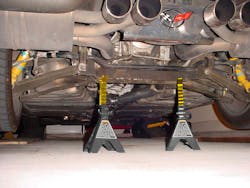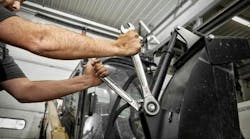We get it – messing with a floor jack and jack stands isn’t ideal. But in certain situations, you might not have a choice but to go back to the basics to get the job done. It may seem like a hassle to manually jack up the vehicle and spend the time getting the jack stands lined up just right so they support the vehicle, but this method is safe and effective when done correctly.
Here are seven tips for safely using jack stands in the shop.
1. Tag team technicians
Sure, if you have the right tools and skills, many vehicle service tasks can be done solo. But it’s nice to have another set of hands and eyes when you’re using jack stands. Grab another tech to check the stands every now and then to make sure they are secure – you can’t see everything at once.
2. Find a level surface
Always use a jack stand or floor jack on a flat surface. If there's more than a slight, barely noticeable slope, the vehicle could roll or shift out of place when the tires lift off the ground. If the vehicle's transmission is automatic, put the car in park. If it's a manual transmission, put it in first gear. Pull the parking brake to ensure your vehicle remains in place.
3. Use wheel chocks
If something were to go wrong and one end of the vehicle rolled forward or backward, wheel chocks could save your life. Even a small roll could shift the underside of your vehicle off the jack stands or floor jack, and that can have serious, even deadly consequences.
4. Use OEM jacking points
Before you even think about lifting a vehicle off the ground, check the vehicle owner’s manual to find the proper jacking points, and pick up at those points only. When jacking up the vehicle, cover as much of the jack point's center as possible, but leave enough room for the jack stand.
5. Jack stand should be on point
Jack stands must be placed directly under the lifting point. There should be enough room at every jack point to accommodate the stand's grip. When releasing hydraulic pressure from the floor jack, a properly rated jack stand will hold the weight of the car as long as the stand is flat. Problems occur if the jack is tilted or the vehicle weight doesn't come down flush on top of the stand.
6. Stability check
Give your car a few light shoves to verify that the stands are all securely in place. Ensure the vehicle is level, with all stands raised to the same height. If everything seems stable, your vehicle should be safe to leave on stands indefinitely under normal conditions.
7. Lowering the vehicle
To lower the vehicle, roll the floor jack under a jacking point, raise the vehicle just above the stand, and remove the stand. Lower the vehicle as slowly as you can. The shocks will easily absorb the descent, even if it seems swift. Once half the vehicle is lowered, remember that you’ll need those wheel chocks again.
Information provided by BendPak, Inc.


